Abstract
In utero infection of fetuses of six specific-pathogen-free large white sows at 35, 48, 55, 72, 99, and 105 days was studied. The fetuses were infected by direct inoculation of porcine parvovirus into the amniotic sac. The inoculation consisted of 0.25 ml of tissue culture fluid containing 10(5.5) mean tissue culture infective doses per ml of porcine parvovirus strain G10/1. Fetuses of one uterus horn were infected, whereas fetuses in the opposite horn were given 0.25 ml of noninfected cell culture material. No clinical signs of infection were observed; however, all sows developed antibodies 7 to 9 days postinfection. A total of 24 virus-inoculated fetuses and 20 control fetuses were studied. Fetuses infected at 35, 48, and 55 days of gestation died between about 5 and 22 days after infection. Virus was isolated from their organs and fetal blood. Virus spread to control fetuses but did not cause death and mummification or stimulate antibody production. Fetuses from sows infected at 72, 99, and 105 days of gestation survived. They developed high antibody titer in utero. Control piglets remained antibody free.
Full text
PDF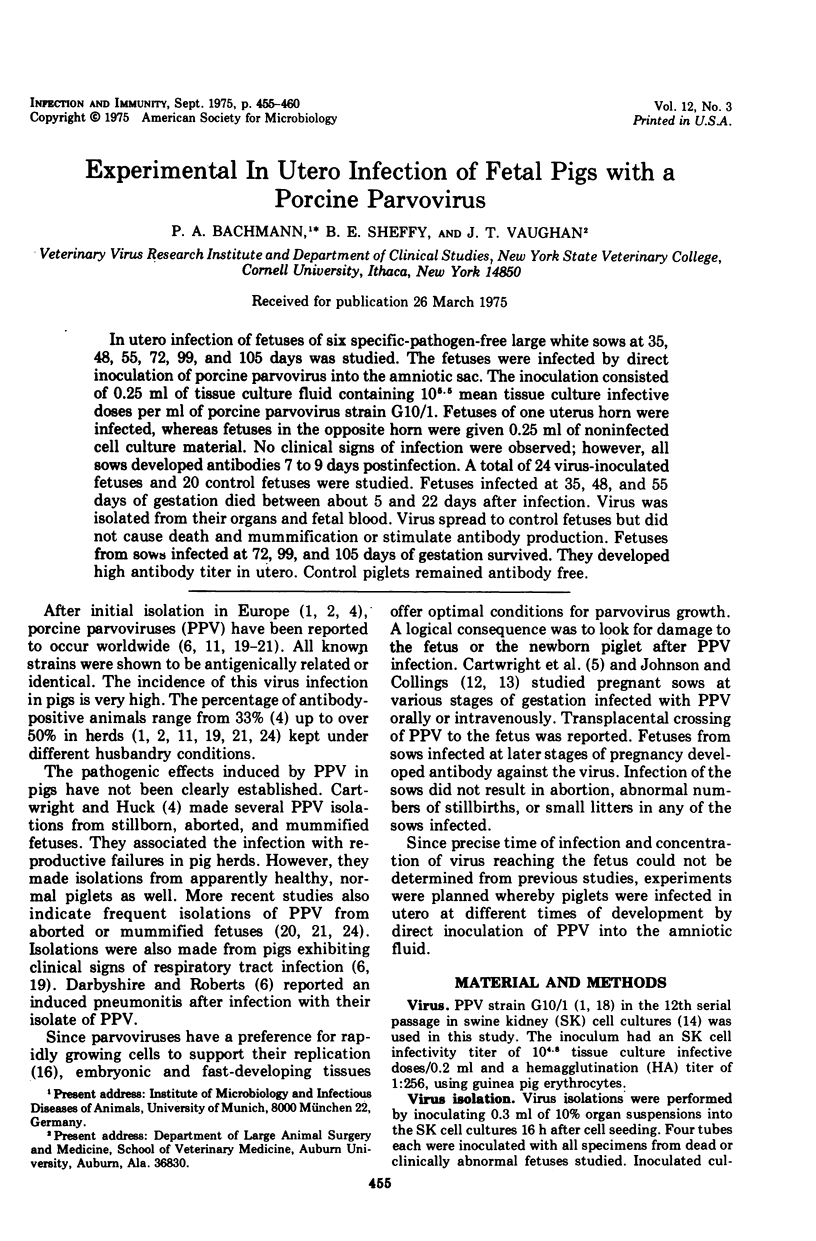
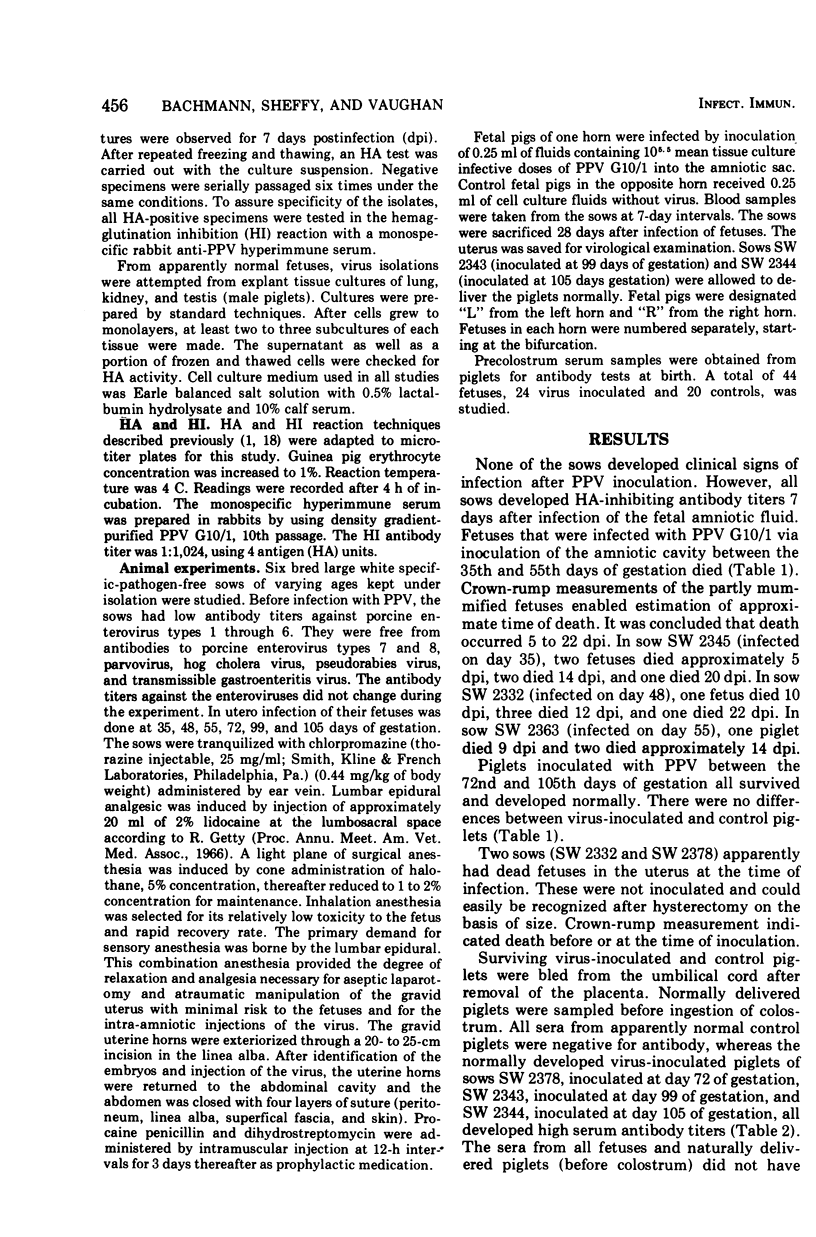
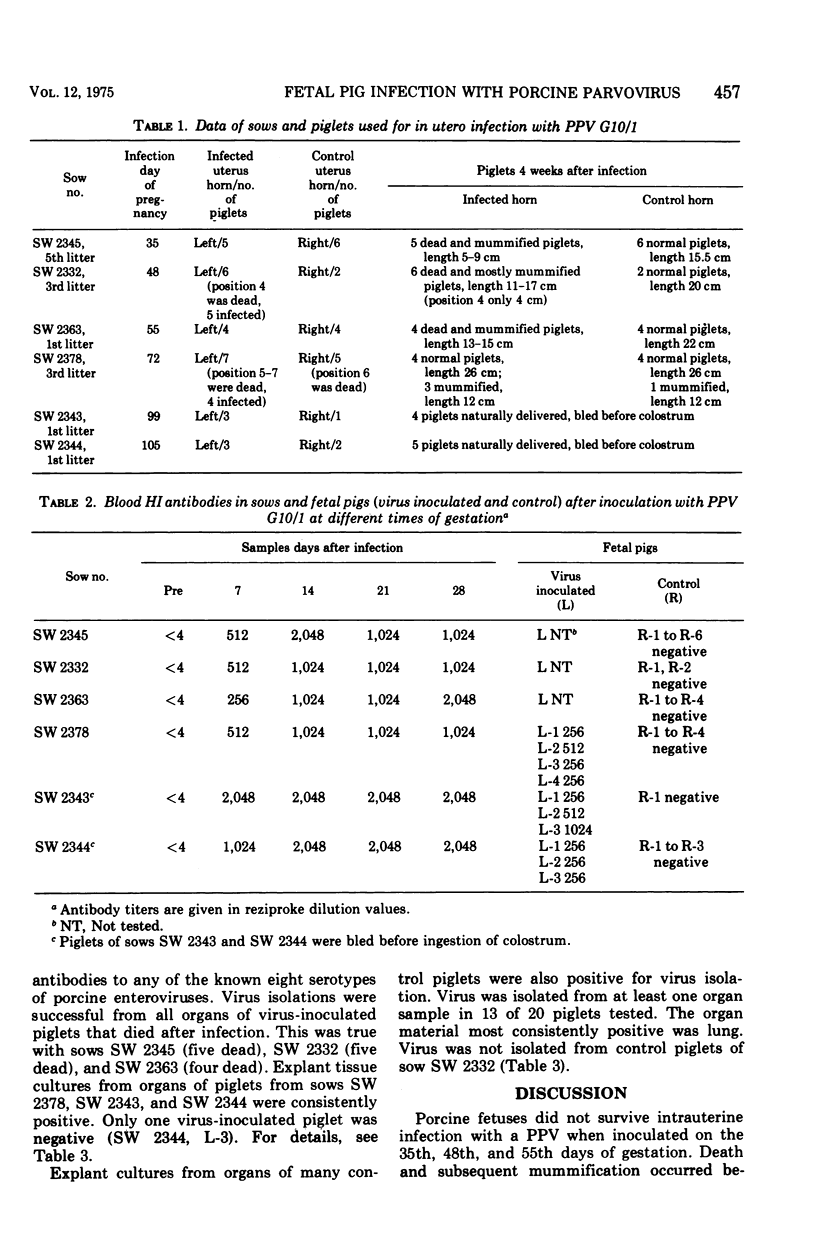
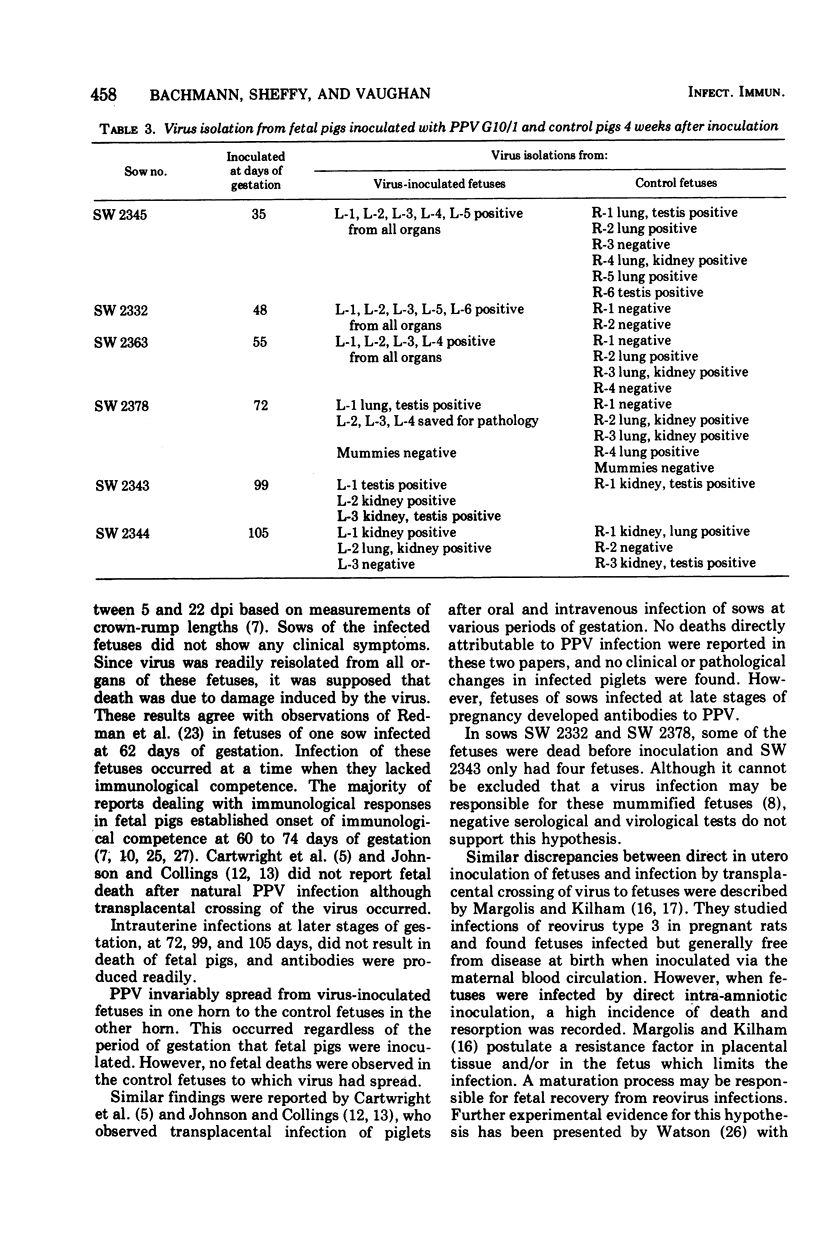
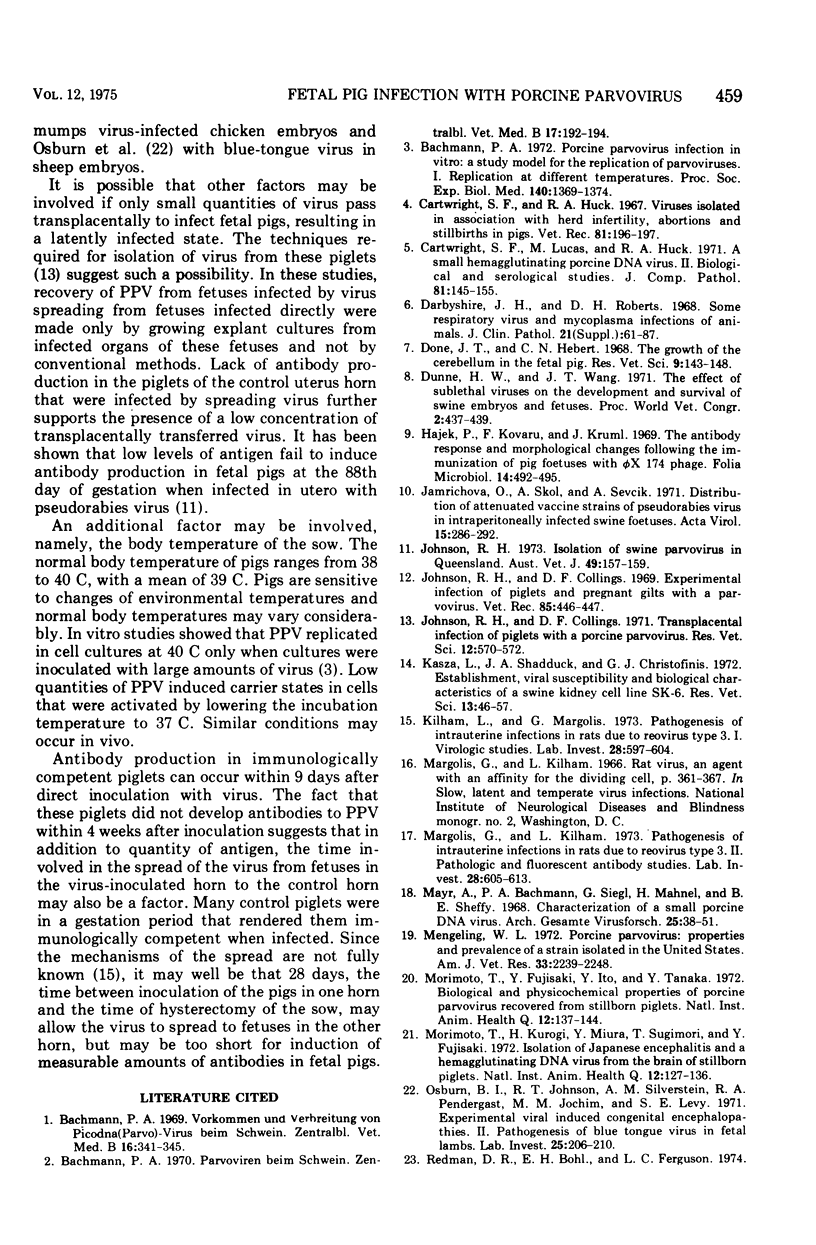
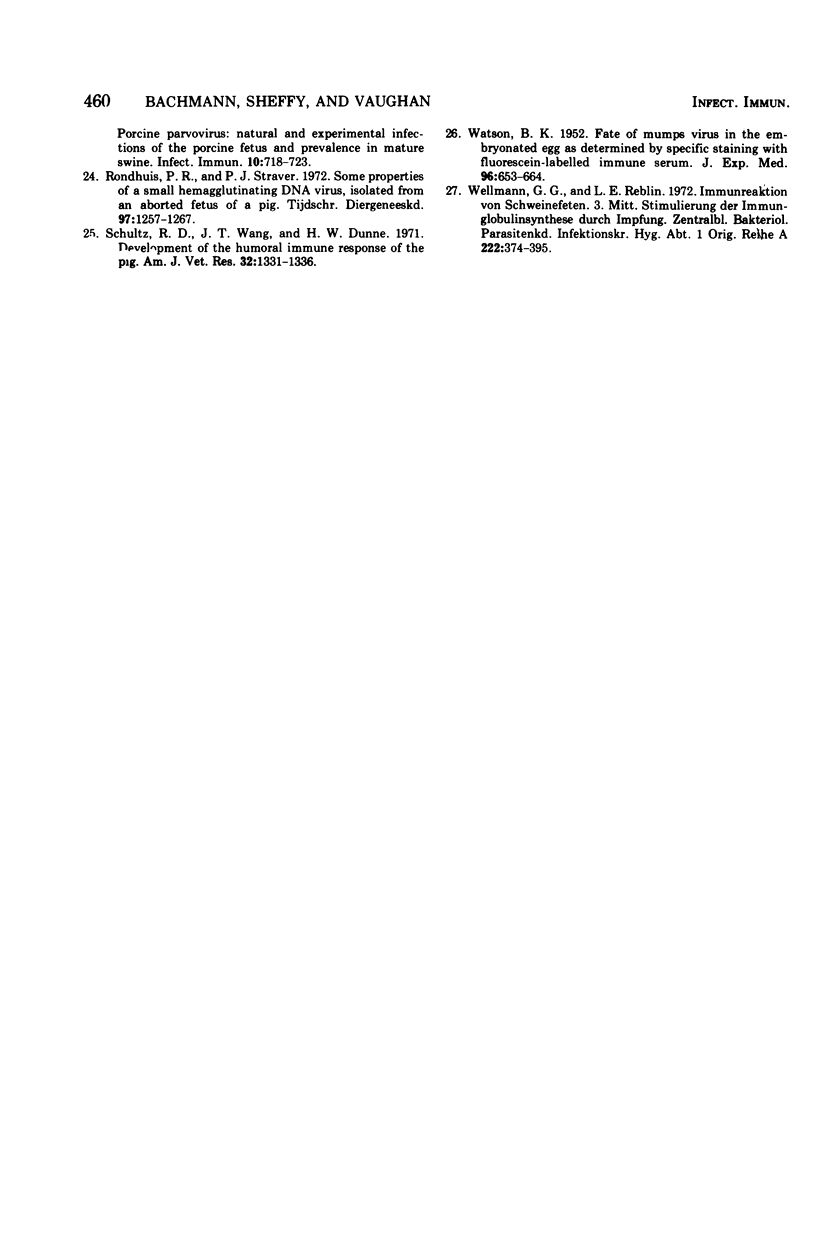
Selected References
These references are in PubMed. This may not be the complete list of references from this article.
- Bachmann P. A. Parvoviren beim Schwein. Zentralbl Veterinarmed B. 1970 Jan;17(1):192–194. [PubMed] [Google Scholar]
- Bachmann P. A. Porcine parvovirus infection in vitro: a study model for the replication of parvoviruses. I. Replication at different temperatures. 1. Proc Soc Exp Biol Med. 1972 Sep;140(4):1369–1374. doi: 10.3181/00379727-140-36676. [DOI] [PubMed] [Google Scholar]
- Bachmann P. A. Vorkommen und Verbreitung von Picodna (Parvo)-Virus beim Schwein. Zentralbl Veterinarmed B. 1969 Jun;16(4):341–345. [PubMed] [Google Scholar]
- Cartwright S. F., Lucas M., Huck R. A. A small haemaggultinating porcine DNA virus. II. Biological and serological studies. J Comp Pathol. 1971 Jan;81(1):145–155. doi: 10.1016/0021-9975(71)90067-3. [DOI] [PubMed] [Google Scholar]
- Darbyshire J. H., Roberts D. H. Some respiratory virus and mycoplasma infections of animals. J Clin Pathol Suppl Coll Pathol. 1968;2:61–92. [PubMed] [Google Scholar]
- Done J. T., Hebert C. N. The growth of the cerebellum in the foetal pig. Res Vet Sci. 1968 Mar;9(2):143–148. [PubMed] [Google Scholar]
- Hájek P., Kovárů F., Kruml J. The antibody response and morphological changes following immunization of pig foetuses with phi chi 174 phage. Folia Microbiol (Praha) 1969;14(5):492–495. doi: 10.1007/BF02872797. [DOI] [PubMed] [Google Scholar]
- Jamrichová O., Sokol A., Sevcík A. Distribution of attenuated vaccine strains of pseudorabies virus in intraperitoneally infected swine foetuses. Acta Virol. 1971 Jul;15(4):286–292. [PubMed] [Google Scholar]
- Johnson R. H., Collings D. F. Experimental infection of piglets and pregnant gilts with a parvovirus. Vet Rec. 1969 Oct 18;85(16):446–447. doi: 10.1136/vr.85.16.446. [DOI] [PubMed] [Google Scholar]
- Johnson R. H., Collings D. F. Transplacental infection of piglets with a porcine parvovirus. Res Vet Sci. 1971 Nov;12(6):570–572. [PubMed] [Google Scholar]
- Johnson R. H. Isolation of swine papvovirus in Queensland. Aust Vet J. 1973 Mar;49(3):157–159. doi: 10.1111/j.1751-0813.1973.tb06768.x. [DOI] [PubMed] [Google Scholar]
- Kasza L., Shadduck J. A., Christofinis G. J. Establishment, viral susceptibility and biological characteristics of a swine kidney cell line SK-6. Res Vet Sci. 1972 Jan;13(1):46–51. [PubMed] [Google Scholar]
- Kilham L., Margolis G. Pathogenesis of intrauterine infections in rats due to reovirus type 3. I. Virologic studies. Lab Invest. 1973 May;28(5):597–604. [PubMed] [Google Scholar]
- Margolis G., Kilham L. Pathogenesis of intrauterine infections in rats due to reovirus type 3. II. Pathologic and fluorescent antibody studies. Lab Invest. 1973 May;28(5):605–613. [PubMed] [Google Scholar]
- Mayr A., Bachmann P. A., Siegl G., Mahnel H., Sheffy B. E. Characterization of a small porcine DNA virus. Arch Gesamte Virusforsch. 1968;25(1):38–51. doi: 10.1007/BF01243088. [DOI] [PubMed] [Google Scholar]
- Mengeling W. L. Porcine parvovirus: properties and prevalence of a strain isolated in the United States. Am J Vet Res. 1972 Nov;33(11):2239–2248. [PubMed] [Google Scholar]
- Morimoto T., Fujisaki Y., Ito Y., Tanaka Y. Biological and physicochemical properties of porcine parvovirus recovered from stillborn piglets. Natl Inst Anim Health Q (Tokyo) 1972 Fall;12(3):137–144. [PubMed] [Google Scholar]
- Morimoto T., Kurogi H., Miura Y., Sugimori T., Fujisaki Y. Isolation of Japanese encephalitis virus and a hemagglutinating DNA virus from the brain of stillborn piglets. Natl Inst Anim Health Q (Tokyo) 1972 Fall;12(3):127–136. [PubMed] [Google Scholar]
- Osburn B. I., Johnson R. T., Silverstein A. M., Prendergast R. A., Jochim M. M., Levy S. E. Experimental viral-induced congenital encephalopathies. II. The pathogenesis of bluetongue vaccine virus infection in fetal lambs. Lab Invest. 1971 Sep;25(3):206–210. [PubMed] [Google Scholar]
- Schultz R. D., Wang J. T., Dunne H. W. Development of the humoral immune response of the pig. Am J Vet Res. 1971 Sep;32(9):1331–1336. [PubMed] [Google Scholar]
- WATSON B. K. Fate of mumps virus in the embryonated egg as determined by specific staining with fluorescein-labelled immune serum. J Exp Med. 1952 Dec;96(6):653–664. doi: 10.1084/jem.96.6.653. [DOI] [PMC free article] [PubMed] [Google Scholar]
- Wellmann G. G., Reblin L. E. Immunreaktionen von Schweinefeten. 3. Stimulierung der Immunglobulinsynthese durch Impfung. Zentralbl Bakteriol Orig A. 1972 Dec;222(3):374–395. [PubMed] [Google Scholar]


